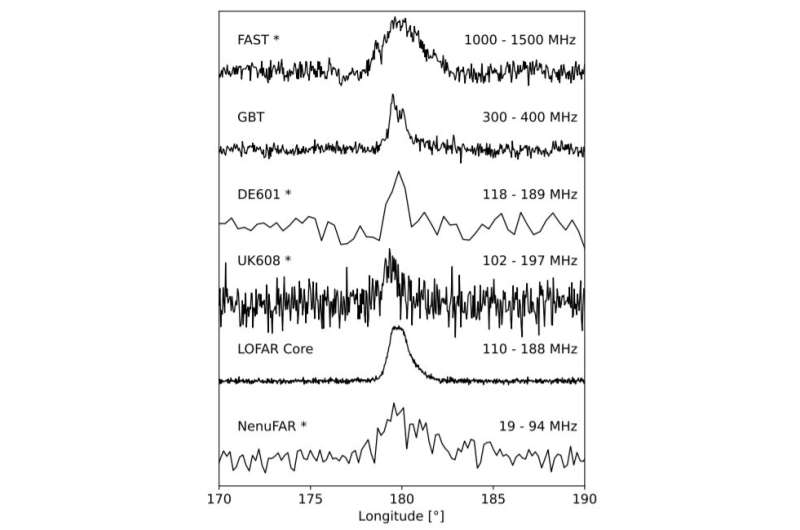September 9, 2021 report
Pulsar PSR J0250+5854 investigated by researchers

Using ground-based facilities, an international team of astronomers has conducted a broadband radio study of a slowly rotating radio pulsar known as PSR J0250+5854. Results of this investigation, published September 1 on the arXiv pre-print server, provide more insights into the nature of this source.
Extraterrestrial sources of radiation with a regular periodicity, known as pulsars, are usually detected in the form of short bursts of radio emission. Radio pulsars are generally described as highly magnetized, rapidly rotating neutron stars with a lighthouse beam of radiation that produces the pulsed emission.
With a period of 23.5 seconds, PSR J0250+5854 is the slowest-spinning radio pulsar known to date. It spins about two times slower than the second slowest-spinning radio pulsar, designated PSR J2251−3711, and almost three times slower than the well-studied pulsar PSR J2144−3933. Previous observations have shown that PSR J0250+5854 has an extremely large light-cylinder (with a radius of about 1.12 million kilometers) and a tiny polar cap (with an estimated diameter of some 60 meters).
Recently, a team of researchers led by Crispin Agar of the University of Manchester, UK, decided to inspect PSR J0250+5854 in order to shed more light on its properties. For this purpose, they performed radio observations of this pulsar using the Five hundred meter Aperture Spherical Telescope (FAST), the Low Frequency Array (LOFAR), and the New Extension in Nançay Upgrading loFAR (NenuFAR).
"We have obtained the highest- and lowest-frequency radio detections of PSR J0250+5854, the most slowly rotating radio-emitting pulsar known, using simultaneous observations from 57 MHz to 1250 MHz," the authors of the paper wrote.
The observations carried out by Agar's team resulted in the first detection of PSR J0250+5854 at frequencies between 1.0 and 1.5 GHz using FAST. Moreover, the NenuFAR detection of PSR J0250+5854 at 57 MHz was the lowest frequency detection of this pulsar ever reported.
The study found that PSR J0250+5854 has a flux density of 4.0 µJy at 1250 MHz and a spectral index of approximately −3.5, with a turnover below 95 MHz. It was noted that the spectral index is exceptionally steep when compared to the mean found for the pulsar population—between -1.6 and -1.4.
Furthermore, the pulse profile of PSR J0250+5854 shows narrowing at lower frequencies, contrary to the expectations of radius-to-frequency mapping. It was also found that the pulsar's polar cap radio emission is produced at an absolute height of several hundreds of kilometers around 1.5 GHz.
"This confirms that the radio beam is very narrow, as expected for such a slow pulsar. Furthermore, the lack of a delay between the profile peak and position angle curve inflection point implies that the emission height of PSR J0250+5854 at 1250 MHz is low, consistent with those found for other non-recycled pulsars," the astronomers explained.
More information: A broadband radio study of PSR J0250+5854: the slowest-spinning radio pulsar known, arXiv:2109.00266 [astro-ph.HE] arxiv.org/abs/2109.00266
Journal information: arXiv
© 2021 Science X Network




















